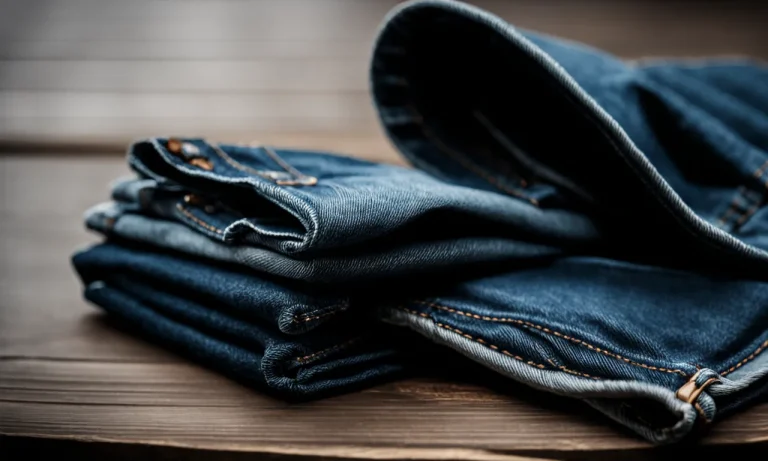Can Fabric Softener Go Bad? Here’S What You Need To Know
If you’ve ever wrinkled your nose at a musty smell from your laundry room, you may be wondering – can fabric softener go bad? With confusing expiration dates and natural separation that occurs over time, it can be tricky to tell if your fabric softener has gone off.
The short answer is: yes, fabric softener can expire and go bad. But with some simple tips for storage and signs to look out for, you’ll be able to get the most out of this laundry staple before it loses its effectiveness.
How to Tell if Fabric Softener Has Gone Bad
Fabric softeners are a popular laundry product used to soften clothes and reduce static cling. But can fabric softener go bad? Here’s what you need to know.
Check the Expiration Date
One of the easiest ways to tell if fabric softener has gone bad is to check the expiration date on the bottle or container. Like many other household products, fabric softeners have a shelf life. Over time, the ingredients in the softener may degrade or become less effective.
If the expiration date has passed, it’s a good indication that the fabric softener may not work as well as it should.
Look for Changes in Color or Smell
Another way to determine if fabric softener has gone bad is to examine its color and smell. Fresh fabric softener typically has a pleasant scent and a consistent color. If you notice any changes, such as a foul odor or a significant change in color, it may be a sign that the softener has gone bad.
It’s also important to note that fabric softener can separate over time, so if you see a layer of liquid or clumps in the bottle, it’s best to discard it.
Test It Out on Fabric
If you’re still unsure whether your fabric softener has gone bad, you can perform a simple test on a small piece of fabric. Apply a small amount of the softener to the fabric and let it dry. If the fabric feels stiff or sticky after drying, it could be an indication that the softener has gone bad.
On the other hand, if the fabric feels soft and smells fresh, the softener is likely still good to use.
It’s important to note that while fabric softener may go bad, it doesn’t pose a health risk. However, using expired or spoiled fabric softener may not provide the desired results and could potentially leave your clothes feeling less soft and smelling less fresh.
For more information on fabric softener and laundry care, you can visit cleanipedia.com or thespruce.com.
Why Fabric Softener Goes Bad
Have you ever wondered if fabric softener can go bad? The answer is yes. Fabric softener, like many other household products, can lose its effectiveness and develop an unpleasant odor over time. There are a few reasons why this happens.
Ingredients Break Down Over Time
Fabric softener contains various ingredients that help to make your clothes feel soft and smell fresh. However, over time, these ingredients can break down and become less effective. For example, the active softening agents in fabric softener can degrade, causing the product to lose its ability to soften fabrics.
This can result in clothes feeling rough and stiff instead of soft and smooth.
In addition, the fragrances used in fabric softeners can also break down over time. These fragrances are designed to provide a pleasant scent to your laundry, but exposure to air and light can cause them to weaken or even become rancid.
This can result in a musty or unpleasant odor being transferred onto your clothes instead of a fresh scent.
Exposure to Air and Light
Exposure to air and light can accelerate the breakdown of fabric softener. When fabric softener is exposed to air, it can oxidize, causing its chemical composition to change. This can lead to a decrease in its effectiveness and the development of a foul smell.
Similarly, exposure to light can also cause the degradation of certain ingredients in fabric softener, making it less effective over time.
To prevent your fabric softener from going bad too quickly, it is important to store it properly. Keep it in a cool, dry place away from direct sunlight and make sure the cap is tightly closed. This will help to minimize exposure to air and light, prolonging the shelf life of your fabric softener.
So, the next time you reach for your fabric softener and notice a strange odor or a lack of effectiveness, it may be time to replace it. Remember, keeping your fabric softener fresh will ensure that your clothes come out of the laundry feeling soft, smelling great, and looking their best!
How to Extend the Shelf Life of Fabric Softener
Fabric softener is a staple in many households, helping to keep clothes soft and smelling fresh. But can fabric softener go bad? The answer is yes, it can. Over time, fabric softener can lose its effectiveness and even develop an unpleasant odor.
To ensure your fabric softener lasts as long as possible, follow these tips to extend its shelf life.
Store in a Cool, Dark Place
To keep your fabric softener in good condition, it is important to store it in a cool, dark place. Exposure to heat and sunlight can cause the ingredients in fabric softener to break down, leading to a decrease in its effectiveness.
Choose a storage area that is away from direct sunlight and sources of heat, such as radiators or hot appliances. A linen closet or laundry room cabinet is an ideal spot for storing fabric softener.
Keep the Lid Tightly Closed
When not in use, make sure to keep the lid of your fabric softener tightly closed. This will help prevent air from entering the container, which can lead to the softener drying out or becoming contaminated.
A tightly closed lid will also help preserve the fragrance of the softener, ensuring your clothes smell fresh when you use it.
Don’t Transfer to Other Containers
Although it may be tempting to transfer your fabric softener to a different container for aesthetic or convenience purposes, it’s best to keep it in its original packaging. The original container is designed to protect the softener from exposure to light and air, helping to maintain its quality.
Transferring the softener to another container could compromise its effectiveness and potentially shorten its shelf life.
Watch for Separation
Over time, fabric softener may start to separate, with the liquid portion settling at the bottom and a thicker layer forming on top. This separation is natural and can be easily remedied by giving the bottle a gentle shake before each use.
However, if the separation becomes excessive or the texture of the softener changes significantly, it may be an indication that the product has gone bad. In such cases, it’s best to dispose of the fabric softener and purchase a fresh bottle.
By following these tips, you can extend the shelf life of your fabric softener and ensure that it remains effective for a longer period of time. Remember to store it in a cool, dark place, keep the lid tightly closed, avoid transferring it to other containers, and watch for signs of separation.
With proper care, your fabric softener will continue to leave your clothes feeling soft and smelling great!
Is Expired Fabric Softener Still Safe to Use?
Many people wonder if fabric softener can go bad and whether it is still safe to use after it has expired. The good news is that fabric softener generally does not become harmful or toxic after its expiration date. However, its effectiveness may be compromised over time.
Generally Safe, But Less Effective
Expired fabric softener is usually safe to use, but it may not work as effectively as fresh fabric softener. Over time, the chemicals and ingredients in fabric softener can break down, which can result in a weaker scent or reduced softening power.
So, while it won’t harm your clothes or your skin, it may not deliver the same level of freshness and softness that you expect.
If you’re using expired fabric softener and notice that your clothes aren’t as soft or fragrant as usual, it might be time to replace it with a fresh bottle. However, if you don’t mind the slightly diminished effects, you can still use expired fabric softener without any major concerns.
Test on Old Towels First
If you’re unsure about the effectiveness of your expired fabric softener, it’s a good idea to test it on old towels or less important garments first. This way, you can see how well it works before using it on your favorite clothes.
If the softener still provides satisfactory results, you can continue using it with confidence. However, if you’re not satisfied with the results, it’s best to discard the expired fabric softener and purchase a fresh one.
Don’t Use if Discolored or Rancid
While fabric softener may not become harmful after it expires, there are a few signs that indicate it’s time to throw it away. If the fabric softener has changed in color, has become lumpy, or has a rancid odor, it’s best to avoid using it.
These signs could indicate that the product has gone bad and may not be safe to use on your clothes.
It’s important to note that fabric softener expiration dates are provided as a guideline for optimal performance, but they are not set in stone. Ultimately, it’s up to you to decide whether you’re comfortable using expired fabric softener based on its condition and effectiveness.
For more information on fabric softener and its expiration, you can visit Cleanipedia, a trusted source for cleaning and laundry tips.
When to Toss Out Fabric Softener
Have you ever wondered if fabric softener can go bad? While fabric softener doesn’t necessarily have an expiration date, it can lose its effectiveness over time. Here are a few signs to look out for when deciding whether to toss out your fabric softener:
Expired Over 1 Year Ago
If your fabric softener has been sitting in your laundry room for over a year past its expiration date, it’s probably time to let it go. Over time, the active ingredients in fabric softener can break down, leading to a less effective product.
While it may still smell good, it won’t provide the same softening and static-reducing benefits as a fresh bottle.
Noticeable Color Changes
Another indication that your fabric softener may have gone bad is if you notice significant changes in its color. If your once clear or lightly colored fabric softener has turned dark or cloudy, it’s a sign that it has started to break down.
This breakdown can affect the performance of the product and may even leave stains on your clothes.
Strong, Rancid Odor
A strong, rancid odor coming from your fabric softener is a clear sign that it’s time to throw it away. Over time, fabric softener can develop a foul smell due to the growth of bacteria or mold. Using fabric softener with a bad odor can transfer the unpleasant smell onto your clothes, defeating the purpose of using it in the first place.
Remember, fabric softener that has gone bad may not necessarily be harmful to use, but it won’t provide the same benefits as a fresh bottle. If you notice any of these signs, it’s best to replace your fabric softener to ensure your clothes stay soft, static-free, and smelling great.
Conclusion
While fabric softener doesn’t necessarily ‘expire’ right on its expiration date, its quality and effectiveness do degrade over time. With some diligent label reading and occasional sniff tests, you can maximize your fabric softener’s shelf life.
But if you notice any changes in color, scent, or performance – it’s probably time to toss and replace.
With proper storage and some best practices, you can keep your favorite fabric softener working for your laundry for months or even years past the expiration date on the bottle.







